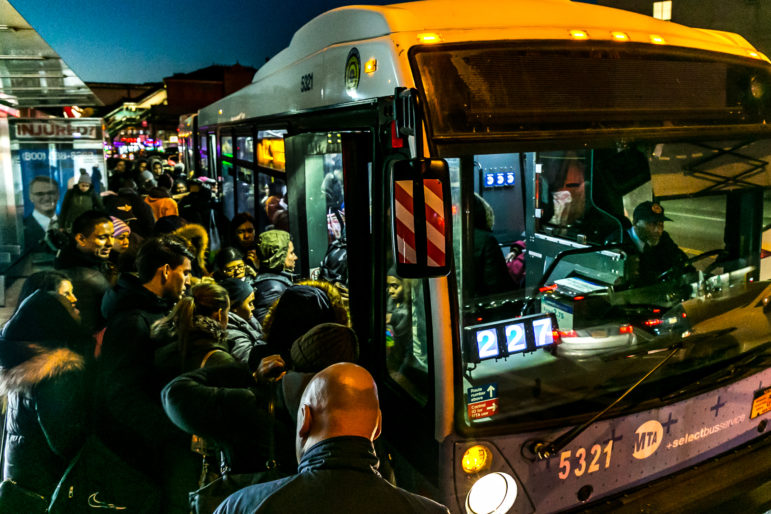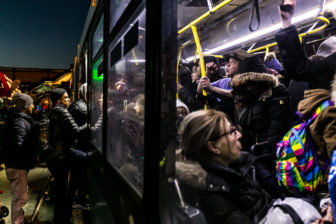
Next year will be a watershed moment for New York’s two million daily bus riders.
Despite record-setting population, job, and tourism numbers, bus speeds and reliability are declining. Bus riders who can afford to are taking cars instead. Increasingly, riders stuck on the bus have no other choice. Bus riders are disproportionately elderly, immigrants, low-income, and people of color. Improving their commutes, and their ability to access everything their city has to offer, is a progressive imperative.
Come January, the city will begin distributing half-price MetroCards to low-income New Yorkers, making the bus more affordable for riders struggling to pay the fare. In March, the state may adopt congestion pricing, which would boost traffic speeds by 20 percent in the core of Manhattan and 7 percent elsewhere, making buses faster.
Together, Fair Fares and congestion pricing would make bus service more accessible and reliable. But to make 2019 the year of the bus rider, Mayor de Blasio needs to add a citywide plan of dedicated, bus-only lanes and speed the roll out of technology that holds and turns traffic lights green for buses.
In April, the Canarsie Tunnel under the East River will close so the MTA can repair damage caused by salt left behind after flooding during Hurricane Sandy. When the L train is out of service between Brooklyn and Manhattan and beneath 14th Street, nearly 300,000 daily riders will need to find new routes to work. Many will take buses for all or part of their trips, both straining the system and creating opportunities for better service.
As part of the L train shutdown plan, the mayor will close 14th Street between 3rd and 8th Avenues to most cars and trucks between 5 a.m. and 10 p.m. daily. The street closure means the MTA can operate replacement shuttle bus service quickly, frequently, and reliably enough to accommodate a projected 84,000 daily riders on what will be the busiest bus route in the nation. The 14th Street busway needs to be effective enough so buses absorb as many L riders as possible, deterring them from switching to cars, which would result in the interborough gridlock labeled L-pocalypse.
To their credit, the city and MTA have worked closely for years to avert L-pocalypse. Given the typical friction of government agencies trying to cooperate and the enmity between the mayor and governor, the plan is no small feat. Like the recent agreement of state and local economic development officials to bring Amazon to Long Island City and last summer’s accord to turn on the city’s speed cameras after the legislature shut them off, the L shutdown plan proves the city and state can get important, complicated, and politically sensitive things done together.
In 2019, while implementing the L plan, the mayor must also undertake his part of the MTA’s Bus Plan to revitalize the citywide system. New York City Transit President Andy Byford committed to redesign the local bus network in each borough so riders have more direct routes and better service at major points of origin and destinations. To seriously increase bus speeds and service reliability, however, Byford said he would need to work with the city, which controls the streets his buses ply and the intersections where they stop and turn.
De Blasio, who has championed housing rights, public education, and access to services for New Yorkers of any immigration status, now needs to tackle the inequity of two million daily bus riders crawling through snarled traffic. Like riders on delayed subway trains, bus riders lose sleep, work hours, pay, jobs, and time with family and friends because of their lousy commutes. For his part, the mayor needs to dedicate more of the city’s public space and resources to meet the needs of bus riders.
The mayor needs to dedicate bus lanes on busy routes through congested neighborhoods citywide. Bus lanes give riders the fair access they deserve as New Yorkers whose time is valuable and who are worthy of full social inclusion. Buses are efficient, environmentally sound, and safe means of travel. The mayor should favor them over private cars on city streets. While individual bus lanes can be controversial, the mayor should prioritize riders’ needs citywide, crafting and implementing a five-borough bus lane plan.
No matter local outcry, the mayor must put riders’ needs before the complaints of relative handfuls of drivers with time and resources to oppose better bus service—even when those drivers are joined by their antediluvian local elected representatives. Favoring large numbers of working people over small numbers of wealthier ones is what it means to be progressive. Caving to cars is regressive.
The mayor also needs to cut the 20 percent of route time bus riders spend waiting at red lights. Holding and turning lights green for buses is a well-established best practice in surface transit. Yet the city is rolling it out far too slowly. The mayor should budget for the resources necessary to promptly reduce riders’ wait times at stop lights.
Making 2019 the year of the bus rider is also a crucial prelude to what’s to come in the next decade of transportation in New York. In 2020, the MTA will embark on a plan to modernize the subway. Already, increased night and weekend downtime for maintenance across the system has transit riders fleeing it. Once modernization begins in earnest, longer-term partial shutdowns of major lines will further imperil New Yorkers’ ability to get around and our street network’s ability to absorb frustrated transit riders.
The solution will be quick, reliable shuttle bus service in bus lanes along streets where lights are held or turned green for buses. If New York and our transit system are to remain viable and our streets anything but gridlocked while the subway enters the 21st century, the L train shutdown must be but a warm up act for busways across the city in years to come. New York’s very future as a vibrant, fair, and sustainable city hinges on the mayor’s willingness to prioritize the needs of New York’s millions of transit riders on our contested streets.
Danny Pearlstein is the policy & communications director for the Riders Alliance.
 Can Buses Be Better?
Can Buses Be Better?
March 2018
More than 2 million riders take buses every day, and they are critical transit resources to outer-borough neighborhoods, the disabled and some of the elderly. Yet buses have been neglected in the debate over New York City’s transit crisis. Is there a way to give passengers a better ride?









2 thoughts on “CityViews: Mayor de Blasio Should Make 2019 the Year of the Bus Rider”
Pingback: Wednesday’s Headlines: Working for Turkey Edition – Streetsblog New York City
Buses are where the city can make the biggest changes, the quickest (compared to the subway).
Congestion pricing is key, along with many more bus lanes, all-door boarding, and signal priority.